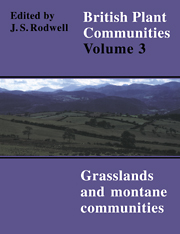Book contents
- Frontmatter
- Contents
- List of Figures
- Preface and Acknowledgements
- Preamble
- Mesotrophic Grasslands
- Community Descriptions
- Calcicolous Grasslands
- Community Descriptions
- Calcifugous Grasslands and Montane Communities
- Community Descriptions
- Index of Synonyms to Grasslands and Montane Communities
- Index of Species in Grasslands and Montane Communities
- Bibliography
U3 - Agrostis Curtisii Grassland
Published online by Cambridge University Press: 04 July 2020
- Frontmatter
- Contents
- List of Figures
- Preface and Acknowledgements
- Preamble
- Mesotrophic Grasslands
- Community Descriptions
- Calcicolous Grasslands
- Community Descriptions
- Calcifugous Grasslands and Montane Communities
- Community Descriptions
- Index of Synonyms to Grasslands and Montane Communities
- Index of Species in Grasslands and Montane Communities
- Bibliography
Summary
Synonymy
Grass-heath Tansley 1911, 1939, Ward et al. 1972a, Tubbs 1986, allp.p.; Festuca-Agrostis grassland Tansley 1939 p.p.; Grassland Ward et al. 1972 p.p.; Acid grassland Tubbs 1986 p.p.
Constant species
Agrostis curtisii, Calluna vulgaris, Danthonia decumbens, Festuca ovina, Galium saxatile, Potentilla erecta.
Rare species
Agrostis curtisii, Erica vagans.
Physiognomy
Agrostis curtisii is an integral element of a number of important heath communities in south-west Britain, and in each of these it can show some abundance among a canopy of sub-shrubs, but the Agrostis curtisii grassland subsumes all those swards in which this grass has dominance over other components of the vegetation. It is a densely caespitose plant, growing as isolated tufted individuals which can expand and coalesce into clumps or a virtually continuous cover from which all but the most strongly competitive associates are excluded.
Usually, however, there are at least a few other grasses present and certain of these can show modest abundance. Festuca ovina, Danthonia decumbens and Agrostis capillaris are the most frequent and where these, together with occasional F. rubra, A. canina ssp. montana and Anthoxanthum odoratum, rival Agrostis curtisii in extent, the vegetation tends to grade to typical Festuca-Agrostis-Galium grassland, a trend especially likely to be seen where the community extends on to less acid and impoverished soils (Tansley 1939, Ward et al. 1972a, Tubbs 1986). Other stands have some Nardus stricta, though this is not very common here and in some areas, like parts of Dartmoor, decidedly scarce, perhaps because of a distinctive grazing history with ponies of continuing importance (Ward et al. 1972a). Then, again, there can be some Molinia caerulea, a grass which often occurs with A. curtisii in the heaths and sometimes becomes abundant with it after burning: indeed, it can be almost co-dominant in this community though, when it exceeds A. curtisii, as is especially likely on moister soils, the vegetation is best considered as grassy Molinia-Potentilia mire. Deschampsia flexuosa is at most occasional and has nothing like the role here that can be seen among heathy grassland in south-east England. More mesophytic grasses, such as Holcus lanatus and Poa spp. figure very rarely, though they are sometimes seen where the Agrostis grassland occurs on some of the stream-side ‘lawns’ in the New Forest (Tubbs 1986).
- Type
- Chapter
- Information
- British Plant Communities , pp. 324 - 330Publisher: Cambridge University PressPrint publication year: 1992

